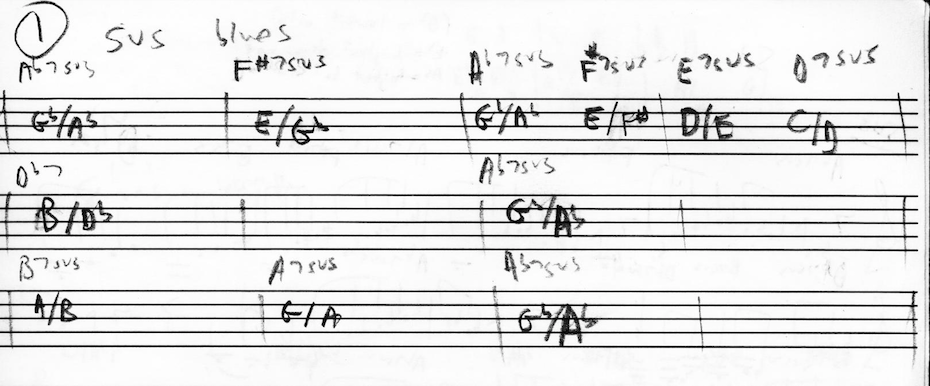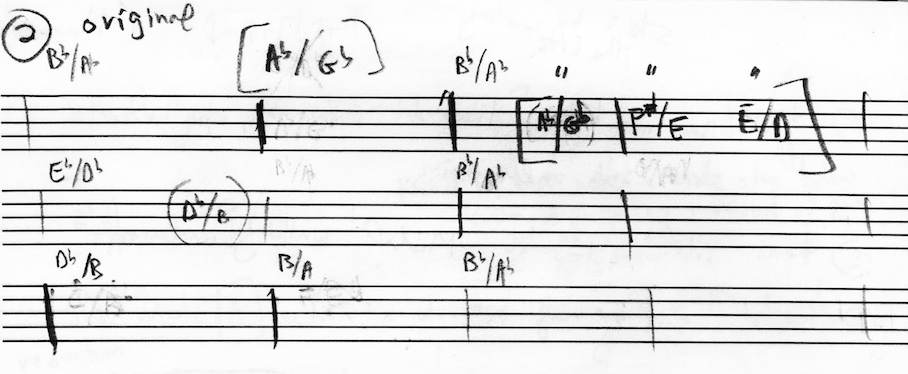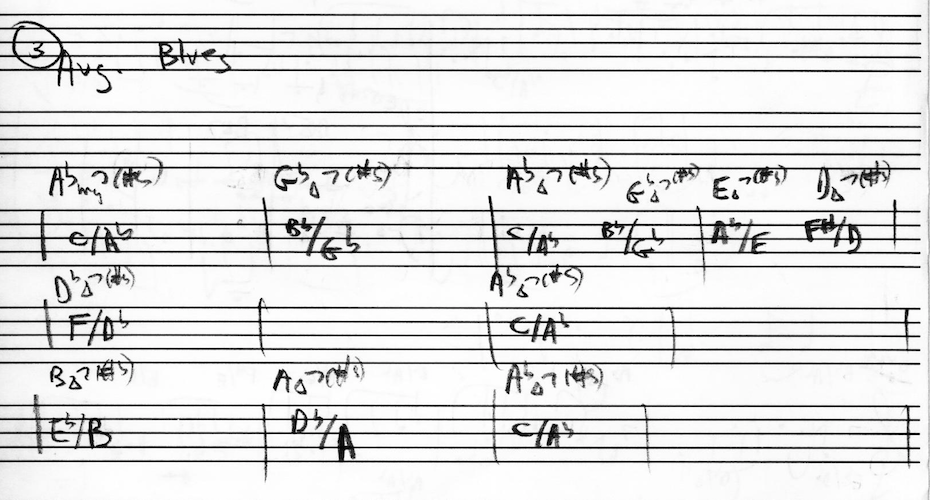Having just completed a big band commission, I thought I’d take a minute to reflect and outline my process and the arranging methods employed, before my recollections are gone forever. With some previous charts, I tried blogging about my compositional process as I worked (a play-by-play account of sorts), but I swore off this practice, because I found myself thinking too much about what I would post, rather than focusing exclusively on the music. It slowed me down and impeded my flow.
This latest arrangement, “What Do You Want From Me?” was composed by Canadian tenor saxophonist, Jerrold Dubyk. 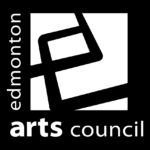 Through the support of the Edmonton Arts Council, he commissioned several arrangers to create big band charts of his small group pieces. He’s planning a concert and subsequent recording. This is the second chart I’ve written for him.
Through the support of the Edmonton Arts Council, he commissioned several arrangers to create big band charts of his small group pieces. He’s planning a concert and subsequent recording. This is the second chart I’ve written for him.
Here’s the original recording and chart given to me:
What Do You Want From Me? (from Jerrold Dubyk’s album, “Invitations,” available through CDBaby.
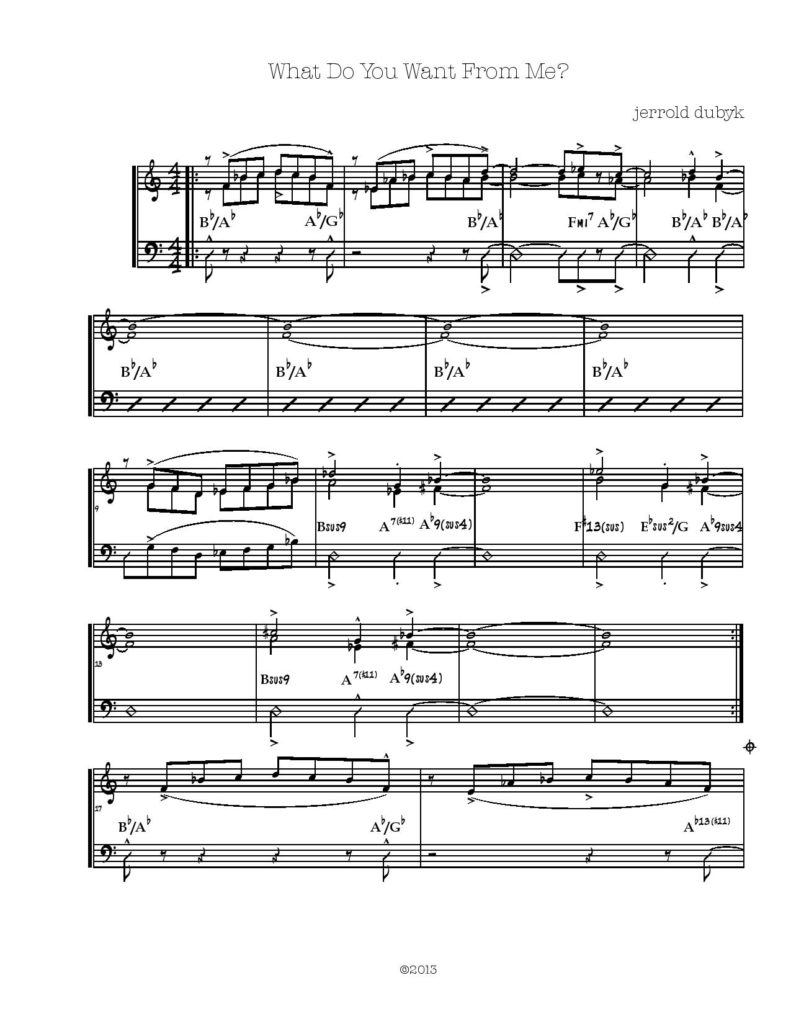 I was provided with the following instructions and song description:
I was provided with the following instructions and song description:
 ‘What Do You Want From Me?’ is a musical statement resulting from some very ‘trying’ conversations with people in my life, leading to a somewhat explosive response in the form of that very question. Originally recorded with a specific set of soloing changes, I’ve recently been soloing on it over Bb blues, because I just liked it better, the tempo is supposed to be “up there” and gives me a chance to add an original blues into my repertoire….
‘What Do You Want From Me?’ is a musical statement resulting from some very ‘trying’ conversations with people in my life, leading to a somewhat explosive response in the form of that very question. Originally recorded with a specific set of soloing changes, I’ve recently been soloing on it over Bb blues, because I just liked it better, the tempo is supposed to be “up there” and gives me a chance to add an original blues into my repertoire….I’m open to your artistic choices. 4 trumpets, 4 bones, 5 saxes (flute and clarinet doubles allowed) and rhythm section with piano, bass, drums, guitar. You can write me into the section or not. Other arrangers are keeping me out front with a full section behind me, but it’s your choice.
After listening to the quintet version a few times, I made the following list of what I liked, what defined the piece, and elements that could potentially be developed:
- the general energy and tempo (it reminded me of something by the band O.T.B.)
- stop-time
- the shape of the eighth-note linear material in the first 2 measures.
- the rhythmic figures in measures 2 – 5 and 10 – 16.
- employment of slash chord harmony
I made this list before analyzing the music, so I would be reacting viscerally (with my gut), rather than intellectually. Analysis followed — both melodically and harmonically, in an attempt to grasp piece’s technical elements.
The opening melodic figure has a pentatonic flavor, but it’s really just triadic, with an added 2nd degree. I refer to these as “add2 triads.” Although at first glance the slash chords look like an inversion of a dominant chord, to my ears, they sound “more open” and should probably be interpreted as Maj6/9(#11) chords, from the bottom up — 1, 6, 9, #11. Moreover, the 3rd (C) is clearly indicated in the melodic line.
Part of my duties as a jazz arranging teacher is working as “a tune Doctor.” I often find myself in the situation of diagnosing what could make student compositions stronger. In this instance, two things troubled me about the piece, once I examined it closely:
- It never strayed far from A flat. The piece could benefit from “going somewhere,” harmonically.
- I couldn’t imagine it working as a Bb blues. In my mind, the piece couldn’t have a modern, lydian-sounding head, and then go to a traditional blues progression with stock, Basie-esque riffs as backgrounds. This seemed like a cop-out. I would have to figure out a solution, so as to keep Jerrold happy, and yet stay true to myself. If the chart had my name on it, I would want every aspect of the piece to be developed and part of a united whole.
My favorite question to ask as an arranger is:
“What if…?”
This question has lead to many interesting discoveries and solutions over the years. What if I took Jerrold’s original slash chord harmony (Bb/Ab) and created a blues progression with it? What if I experimented with different slash chord combinations (trying different bass notes under triads), and applied these to the blues? What if I gradually increased the tension over the duration of the chart with different blues progressions, derived from varying slash chord combinations? What if I deviated from Bb (or Ab) as the key for the solos? What if I wrote a soli over each blues progression, reflecting the subtle harmonic differences implied by the slash chords?
Booyah! A plan was starting to take shape. In addition to a melody statement, I now had 3 slightly different blues progressions for which I’d write solis and assign different soloists. Background choruses would be included to guide and shape the solos. But, something was needed between solos, to “break things up,” and serve as a transition. I decided to develop the rhythmic and harmonic material in the second half of Jerrold’s tune. I deliberately visited different harmonic areas, to get away from the home key and to achieve the sensation of going someplace.
Here are my three blues progressions comprised exclusively of “slash chords”:
“Sus Chord” Blues:
Maj7(#11) Blues (II/I or I/bVII):
Maj7(#5) Blues (Augmented):
Lastly, I developed an introduction. It’s funny how the introduction is usually the final thing I write. By doing so, I can subtly foreshadow material which appears later. In this case I wanted to heighten the anger/frustration evoked in the title, by featuring the drums. I also developed the stop-time idea with ensemble hits throughout the drum solo, which hinted at a blues progression, while not rigidly adhering to a 12-measure form.
In keeping with the idea of building tension through to the end, the high point of the piece is the last chord.
Done. [Well… sort of.] Once I had a plan in place, the chart practically wrote itself. After sketching things out in my notebook, I counted the number of measures for each section and created a Finale file, complete with rehearsal letters, repeat signs/endings, and double bar lines. All of this was in place before entering a single note into the computer. I then worked section by section, “filling in the blanks,” until the piece was completed.
As I was wrapping up the piece, I had a gig playing piano with the New London Big Band (which includes many members of the US Coast Guard Band). They are all great sight-readers, and they graciously agreed to read the piece (without rehearsal) on the gig. Here’s a recording of that performance.
My big band arrangement of “What Do You Want From Me,” sight-read on the gig, by the New London Big Band.
Subsequently I tweaked the dynamics and made some slight orchestration changes before submitting it to Jerrold. Once he records it, or I get an opportunity to rehearse it with a student ensemble, I’ll replace the live recording here with a more polished version.
I hope this post sheds some light onto the arranging process and the behind-the-scenes work which goes into producing a piece of music for jazz big band. It takes hours and hours, but it’s a stimulating challenge, which is rewarded upon hearing it successfully brought to life by good musicians.

